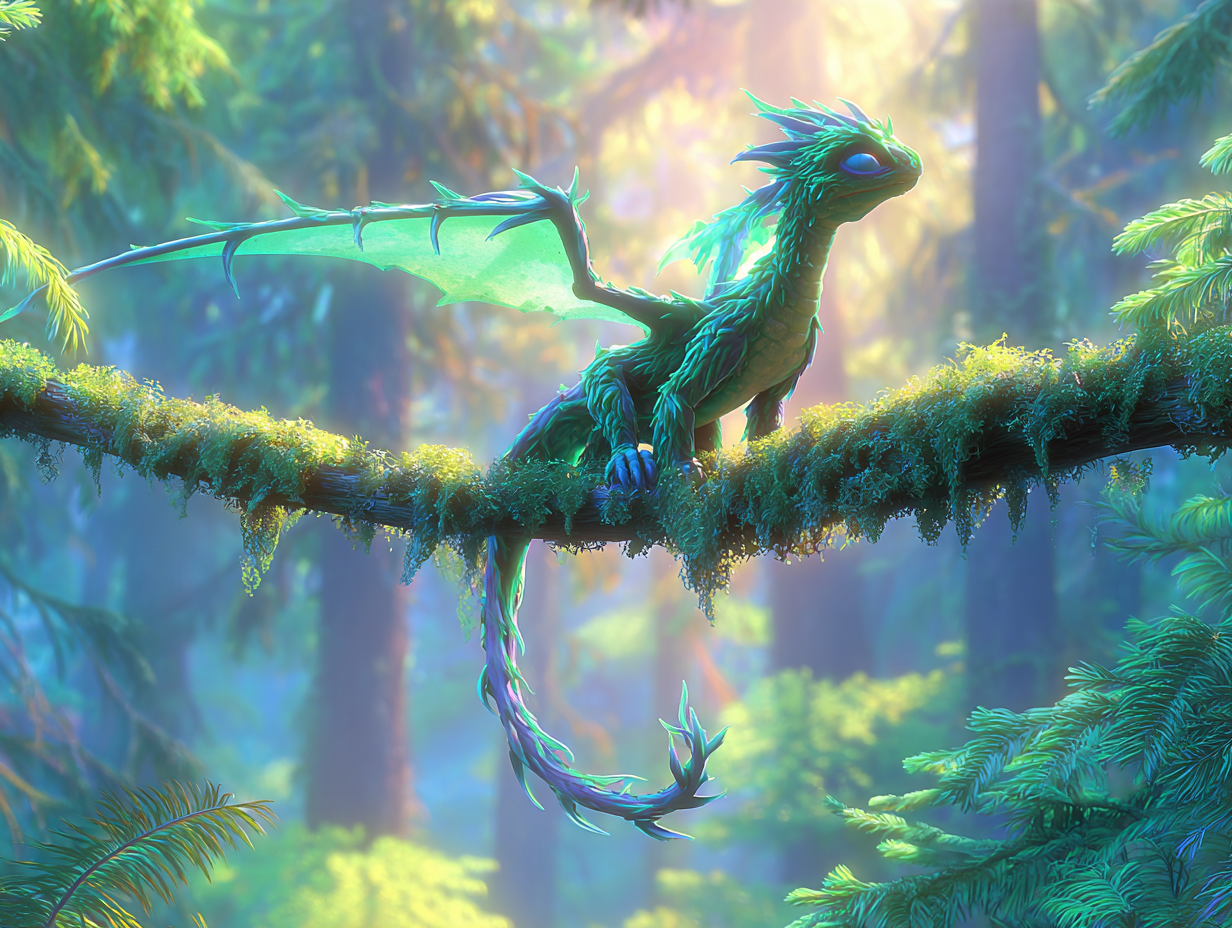Rift Vinetail
The Rift Vinetail is a diminutive species of zilant that inhabits the Shatterscale Rift and the surrounding valley. Its striking coloration features a deep forest green adorned with a subtle blueish hue, allowing it to seamlessly blend into the wooded environment. This agile wyvern possesses a long, prehensile tail, which it uses to suspend itself from branches.
Basic Information
Anatomy
The rift vinetail is classified as a zilant, a unique variant of wyvern. Unlike the conventional wyvern anatomy, which features wings and only two hind legs, the zilant is distinguished by its two front legs. This anatomical structure puts the wings behind its legs, which is the opposite of typical wyverns.
However, the vinetail's most notable characteristic is its elongated, prehensile tail, which is finely adapted for both grasping and balancing. The tail and the rest of its body resemble a mossy or leafy vine. The length and prehensile ability of its tail enable the wyvern to hang effortlessly from tree branches. The vine-like appearance not only aids in camouflage among the foliage but also grants the creature a unique identity, cementing its name as the vinetail.
In the later seasons, the vinetail's few leaf-like scales on its tail shed and regrow in a brown hue. This color change mirrors the surrounding vines and plant life that enter into hibernation during the colder months, effectively allowing the vinetail to maintain its camouflage throughout the year.
The exfoliated scales resemble delicate leaves; however, they do not decompose like plant matter. During the autumn and spring seasons, people will visit the Shatterscale Valley to forage for these shed scales to use in their crafts.
Dietary Needs and Habits
The diet of the rift vinetail is quite varied and includes a range of prey such as insects, small mammals like rodents, various species of birds, as well as fish and snakes. During the early hatchling stages, young vinetails do consume insects; however, they tend to avoid rift scarabs due to the difficulty in capturing them and their appalling taste.
A distinctive hunting technique employed by the vinetail involves hanging from branches using its slender, prehensile tail, mimicking the appearance of a mossy or leafy vine to blend into its surroundings. It will suddenly retract, launching itself upward to snatch unsuspecting birds or squirrels perching nearby. With its strong front claws, the vinetail adeptly grasps its prey, ensuring a successful catch.
Additional Information
Domestication
While these zilants are classified as a protected species and are not domesticated, a select number of enthusiasts do keep them as exotic pets. Even when vinetails lay eggs in captivity, they still instinctively search for rift scarab larvae.
To mitigate stress and prevent potential chaos within the home, owners often provide their vinetails with a stuffed plushie of a rift scarab larva, which helps to calm them down. It is not necessary to offer real rift scarabs to the vinetail, as the nests are kept clean and safe from environmental hazards while they are in captivity.
Symbiotic and Parasitic organisms
Rift Vinetails develop a symbiotic relationship with the Rift Scarabs that inhabit the forest floor of the Shatterscale Valley. During the scarab's early larval stage, vinetails will seek out and capture Rift Scarab larvae and bring them into their nests. The presence of the scarabs serves a critical role within the wyverns' habitat by efficiently eliminating unwanted pests, particularly Wyvern Wasps, which can pose a serious threat to the vinetail's eggs.
In this mutual arrangement, the vinetail provides a safe haven for the rift scarab larvae, guarding them from predators and environmental hazards until they reach maturity. However, once the beetles mature, they are expelled from the wyvern's nest, as their newfound size and appetite could pose a risk of them consuming the eggs.
Genetic Ancestor(s)
Scientific Name
Zilant vinetail
Conservation Status
Protected; unique to the Shatterscale Valley and Rift
Average Length
3 - 4 ft
(0.9 - 1.2 m)
(0.9 - 1.2 m)
Average Physique
Small
Body Tint, Colouring and Marking
Deep forest-green with a blue hue
Geographic Distribution








I really like the thought of its prehensile tail and it hanging down from tree branches. That is a fun image.
Explore Etrea | WorldEmber 2025
Such an innocent-looking vine, until it flies at you XD
> Root Directory is my hub world <
Legends of the Dragonguard • /dev/null
WorldEmber 2025